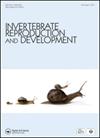Onset of sexual maturity of sexually propagated and wild colonies of the massive coral Favites abdita in northwestern Philippines
IF 0.8
4区 生物学
Q4 REPRODUCTIVE BIOLOGY
引用次数: 3
Abstract
ABSTRACT Despite decades of research, many aspects of coral reproductive biology, such as colony size and age at the onset of sexual maturity remain poorly studied. In this study, wild colonies of different size classes and colonies of a known age of the massive scleractinian Favites abdita were examined for the presence or absence of mature oocytes to determine size and age at the onset of maturity. Fecundity for each size class was also determined for wild colonies. Both sexually propagated and wild F. abdita colonies that are 1.8 cm in diameter were found to be sexually mature. Colonies of size class A (0.1–4.0 cm maximum diameter) had lower mean oocyte counts but greater mean oocyte geometric mean diameter per polyp (44 ± 6.08, 340.38 ± 7.68 µm; mean ± SE) compared to colonies of classes B (4.1–8.0 cm) and C (>8.1 cm) (469 ± 62.41, 283.96 ± 6.94 µm; 278 ± 57.15, 317.57 ± 9.18 µm, respectively). Results of this study bring into question the widely applied operational definition of juveniles being colonies ≤4.0 cm diameter and suggest that even quite small colonies can play a role in contributing to the natural larval pool on reefs than previously thought.菲律宾西北部大型珊瑚Favites abdita有性繁殖和野生群体性成熟的开始
尽管经过数十年的研究,珊瑚生殖生物学的许多方面,如群落大小和性成熟开始时的年龄,仍然缺乏研究。在这项研究中,研究人员检测了不同大小类别的野生菌落和已知年龄的大型sccleractiinian Favites abdita菌落的成熟卵母细胞的存在或缺失,以确定成熟开始时的大小和年龄。还测定了野生蚁群各大小类的繁殖力。有性繁殖的和野生的F. abdita菌落均为直径1.8 cm的性成熟菌落。A级菌落(最大直径0.1 ~ 4.0 cm)的平均卵母细胞计数较低,但每个息肉的平均卵母细胞几何平均直径较大(44±6.08,340.38±7.68µm);B类(4.1 ~ 8.0 cm)和C类(> ~ 8.1 cm)菌落分别为(469±62.41、283.96±6.94µm);分别为278±57.15、317.57±9.18µm)。本研究的结果对广泛应用的幼鱼群体直径≤4.0 cm的操作定义提出了质疑,并表明即使很小的群体也可以比以前认为的在珊瑚礁上对自然幼虫池做出贡献。
本文章由计算机程序翻译,如有差异,请以英文原文为准。
求助全文
约1分钟内获得全文
求助全文
来源期刊
CiteScore
1.90
自引率
0.00%
发文量
21
审稿时长
>12 weeks
期刊介绍:
Invertebrate Reproduction & Development ( IRD) presents original research on the reproductive and developmental biology of the Invertebrata, both embryonic and postembryonic. IRD welcomes papers reporting significant results obtained using new techniques. Encouraged topic areas include: aquaculture, physiology, biochemistry, functional morphology, phylogeny, behavioural and regulatory mechanisms, including genetic, endocrine and molecular studies. Papers containing qualitative descriptions of reproductive cycles and gametogenesis will not be considered. IRD is published in association with the International Society of Invertebrate Reproduction and Development.

 求助内容:
求助内容: 应助结果提醒方式:
应助结果提醒方式:


